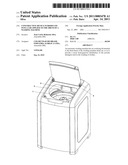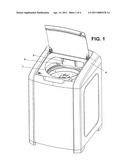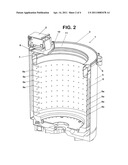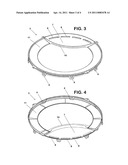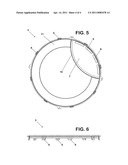Patent application title: Constructive device introduced into a lid applied to the drum of a washing machine
Inventors:
Jean Carlos Belmonte Silva (Aracatuba, BR)
Assignees:
COLOR VISAO DO BRASIL INDUSTRIA ACRILICA LTDA.
IPC8 Class: AD06B100FI
USPC Class:
68200
Class name: Textiles: fluid treating apparatus machines liquid applying
Publication date: 2011-04-14
Patent application number: 20110083478
hine has an overlying lid attached to the fixed
drum of the washing machine drum set, so as to provide a more homogeneous
distribution of the powder detergent used in the washing of clothes.Claims:
1. An automatic washing machine comprising: an internal drum comprising a
fixed drum holding a concentric rotating drum inside said fixed drum; a
dispenser attached to a top panel of the washing machine above said drum,
said dispenser mixing water and detergent that is poured into the washing
machine; and an overlying lid attached to the fixed drum by latches, said
lid being located between the dispenser and the internal drum, said lid
having a semi-circular projection located beneath the dispenser and
having oblong orifices.Description:
CROSS REFERENCE TO RELATED APPLICATIONS
[0001] Applicant claims priority under 35 U.S.C. §119 of Brazilian Patent Application No. MU 8901999-7 filed Sep. 23, 2009.
INTRODUCTION
[0002] This invention relates to an improvement made to an automatic washing machine. More precisely, the invention relates to a constructive device applied to the lid over the washing machine drum, in order to provide a more homogeneous distribution of the powder detergent and prevent stains on the clothes.
PRIOR ART
[0003] The automatic washing machines known to this date contain a dispenser coupled to the top panel, whose function is to store the powder detergent and have it mixed and dissolved in the clothes washing water.
[0004] Usually, this container is located at the top panel, above the water drum containing the clothes to be washed, and receive an amount of water propelled by the local water piping through a solenoid valve, so as to mix the powder detergent to the washing water and thereby form a mix of water and dissolved detergent to clean the clothes in the drum.
[0005] The washing machine drum is formed by a concentric set comprised of a fixed drum and a rotating drum.
[0006] However, it is known that these dispensers coupled to the top panel over the washing machine drum simply pour the mix of water and detergent directly onto the clothes placed inside the drum. The powder detergent in the water mix poured onto the clothes is not always dissolved and, consequently, some detergent grains fall onto the clothes and spread over them, as some pieces or parts of clothes are not fully submerged in the washing water. In this case, it takes longer for the powder detergent to dissolve, which decreases the efficiency of the washing and creates the possibility of stains the clothes, depending on the type of fabric used.
[0007] Due to such inconvenience, an improvement was developed on the part located on the edge of the washing machine drum and above the dispenser, specially designed to promote a more homogeneous distribution of the water and powder detergent, preventing the undissolved detergent powder from falling onto the clothes that are not submerged in the washing machine drum water.
[0008] The improvement made to the lid placed over the washing machine drum is explained in details in the attached images.
BRIEF DESCRIPTION OF THE FIGURES
[0009] FIG. 1 shows a perspective view of an automatic washing machine with its lid half open;
[0010] FIG. 2 shows a perspective view in partial cross section of the washing machine drum set;
[0011] FIG. 3 shows a front perspective view of the overlying lid, object of this application;
[0012] FIG. 4 shows a rear perspective view of the overlying lid, object of this application;
[0013] FIG. 5 shows a top view of the overlying lid, object of this application; and
[0014] FIG. 6 shows a side view of the overlying lid, object of this application; and
DETAILED DESCRIPTION OF THE EMBODIMENT
[0015] As shown in FIG. 1, the automatic washing machine has an internal drum (1) that forms a set comprised of a fixed drum (5) that holds a concentric rotating drum (9) inside it, above which drum (1) there is a dispenser (2) attached to the washing machine top panel (4), which mixes the powder detergent and the water to be poured into the washing machine drum (1). Between the dispenser (2) and the drum set (1) there is an overlying lid (3).
[0016] As shown in FIG. 2, the dispenser (2) of the washing machine top panel (4) is located above the overlying lid (3), which is attached to the drum (5) by means of latches (6). The overlying lid (3) has a projection (7) in semi-circular shape that extends to the region of the dispenser, which is intended to collect the mix of water and detergent released by the dispenser (2) and channel it to the edges of the overlying lid (3). These edges have oblong orifices (8) through which the mix of water and detergent flows into the walls of the fixed drum (5) and the rotating drum (9) and is homogeneously distributed into the drum (9) through its orifices (9a), as indicated by the illustration arrows.
[0017] FIGS. 3 to 6 show the overlying lid (3) in details. FIG. 4 shows the extending semi-circular projection (7) located on a lower level than the circular side edges (11) of the overlying lid (3), while these edges have an angled tilt toward the inside of the drum (1). Due to said tilt and the existence of a stopper (10), the mixture of water and detergent flows to the edges of the overlying lid (3), toward the oblong orifices (8) positioned in the space between the fixed drum (5) and the rotating drum (9), so that the mixture of water and detergent is poured onto this space. With the rotational movement of the drum (9) inside the fixed drum (5), the water and detergent mixture is mixed before getting in direct contact with the clothes, promoting thereby a more homogenous distribution of such mixture inside the rotating drum (9) through the orifices (9a) and finally mixing with the clothes.
[0018] The latches (6) on the overlying lid (3) are meant to fix the overlying lid onto the fixed drum (5).
[0019] The description above demonstrates the best use provided by the new constructive device applied to an overlying lid (3) to the drum set (1) of automatic washing machines.
Claims:
1. An automatic washing machine comprising: an internal drum comprising a
fixed drum holding a concentric rotating drum inside said fixed drum; a
dispenser attached to a top panel of the washing machine above said drum,
said dispenser mixing water and detergent that is poured into the washing
machine; and an overlying lid attached to the fixed drum by latches, said
lid being located between the dispenser and the internal drum, said lid
having a semi-circular projection located beneath the dispenser and
having oblong orifices.Description:
CROSS REFERENCE TO RELATED APPLICATIONS
[0001] Applicant claims priority under 35 U.S.C. §119 of Brazilian Patent Application No. MU 8901999-7 filed Sep. 23, 2009.
INTRODUCTION
[0002] This invention relates to an improvement made to an automatic washing machine. More precisely, the invention relates to a constructive device applied to the lid over the washing machine drum, in order to provide a more homogeneous distribution of the powder detergent and prevent stains on the clothes.
PRIOR ART
[0003] The automatic washing machines known to this date contain a dispenser coupled to the top panel, whose function is to store the powder detergent and have it mixed and dissolved in the clothes washing water.
[0004] Usually, this container is located at the top panel, above the water drum containing the clothes to be washed, and receive an amount of water propelled by the local water piping through a solenoid valve, so as to mix the powder detergent to the washing water and thereby form a mix of water and dissolved detergent to clean the clothes in the drum.
[0005] The washing machine drum is formed by a concentric set comprised of a fixed drum and a rotating drum.
[0006] However, it is known that these dispensers coupled to the top panel over the washing machine drum simply pour the mix of water and detergent directly onto the clothes placed inside the drum. The powder detergent in the water mix poured onto the clothes is not always dissolved and, consequently, some detergent grains fall onto the clothes and spread over them, as some pieces or parts of clothes are not fully submerged in the washing water. In this case, it takes longer for the powder detergent to dissolve, which decreases the efficiency of the washing and creates the possibility of stains the clothes, depending on the type of fabric used.
[0007] Due to such inconvenience, an improvement was developed on the part located on the edge of the washing machine drum and above the dispenser, specially designed to promote a more homogeneous distribution of the water and powder detergent, preventing the undissolved detergent powder from falling onto the clothes that are not submerged in the washing machine drum water.
[0008] The improvement made to the lid placed over the washing machine drum is explained in details in the attached images.
BRIEF DESCRIPTION OF THE FIGURES
[0009] FIG. 1 shows a perspective view of an automatic washing machine with its lid half open;
[0010] FIG. 2 shows a perspective view in partial cross section of the washing machine drum set;
[0011] FIG. 3 shows a front perspective view of the overlying lid, object of this application;
[0012] FIG. 4 shows a rear perspective view of the overlying lid, object of this application;
[0013] FIG. 5 shows a top view of the overlying lid, object of this application; and
[0014] FIG. 6 shows a side view of the overlying lid, object of this application; and
DETAILED DESCRIPTION OF THE EMBODIMENT
[0015] As shown in FIG. 1, the automatic washing machine has an internal drum (1) that forms a set comprised of a fixed drum (5) that holds a concentric rotating drum (9) inside it, above which drum (1) there is a dispenser (2) attached to the washing machine top panel (4), which mixes the powder detergent and the water to be poured into the washing machine drum (1). Between the dispenser (2) and the drum set (1) there is an overlying lid (3).
[0016] As shown in FIG. 2, the dispenser (2) of the washing machine top panel (4) is located above the overlying lid (3), which is attached to the drum (5) by means of latches (6). The overlying lid (3) has a projection (7) in semi-circular shape that extends to the region of the dispenser, which is intended to collect the mix of water and detergent released by the dispenser (2) and channel it to the edges of the overlying lid (3). These edges have oblong orifices (8) through which the mix of water and detergent flows into the walls of the fixed drum (5) and the rotating drum (9) and is homogeneously distributed into the drum (9) through its orifices (9a), as indicated by the illustration arrows.
[0017] FIGS. 3 to 6 show the overlying lid (3) in details. FIG. 4 shows the extending semi-circular projection (7) located on a lower level than the circular side edges (11) of the overlying lid (3), while these edges have an angled tilt toward the inside of the drum (1). Due to said tilt and the existence of a stopper (10), the mixture of water and detergent flows to the edges of the overlying lid (3), toward the oblong orifices (8) positioned in the space between the fixed drum (5) and the rotating drum (9), so that the mixture of water and detergent is poured onto this space. With the rotational movement of the drum (9) inside the fixed drum (5), the water and detergent mixture is mixed before getting in direct contact with the clothes, promoting thereby a more homogenous distribution of such mixture inside the rotating drum (9) through the orifices (9a) and finally mixing with the clothes.
[0018] The latches (6) on the overlying lid (3) are meant to fix the overlying lid onto the fixed drum (5).
[0019] The description above demonstrates the best use provided by the new constructive device applied to an overlying lid (3) to the drum set (1) of automatic washing machines.
User Contributions:
Comment about this patent or add new information about this topic:

